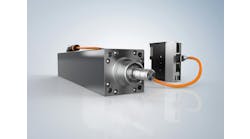There is no doubt hydraulics has unmatched muscle, compared to pneumatics or electrical power transmission in linear and rotary motion applications. While pneumatics may win the game when it comes to simple, low-cost and fast linear motion, hydraulics has never been better.
Although many oil-leaking, hot, noisy hydraulic power units are still in service today, hydraulic technology has developed well over the years. Don't let oil leaks from the past sway your decision to use hydraulics. Leaks have been addressed and power units are quieter making it a great option for some applications. New sealing technology has all but eliminated the puddles of oil under and around hydraulic devices. Fewer leaks also open the door to higher operating pressures, and adding sound insulation in key locations has dramatically lowered system noise, as well.
Check out a few basics on hydraulic systems and don't reinvent the wheel when designing and using this capable power transmission method. It does have its advantages.
In a closed system, Pascal's law, which is the foundation of hydraulic drive systems, states that the pressure anywhere is the same. Therefore, the force that the fluid transfers to the surroundings is equal to pressure x area. The bigger the piston, the larger the force.
Both pneumatic and hydraulic fluid-power systems are used in a variety of industrial machinery and off-highway equipment. While pneumatics can transfer high force and torque in power-transmission applications, it is often used in linear-motion applications such as transferring, lifting, clamping, gripping and stamping. These applications are usually repetitive and fast moving, as well.
It's the heavy force and torque applications that benefit from the use of hydraulic systems. These applications typically involve tons of force such as pressing metal, lifting large loads, digging or crushing rock. While these hydraulic systems eliminate many of the drives, gears, chains, pulleys, drive shafts and ball screws of an electrically driven system, there are many fluid-power system components that need to work together.
Considering the amount of power produced, hydraulic components are relatively compact. It's one of the reasons they’re used in mobile construction and agricultural equipment. A 5-hp hydraulic motor could fit in the palm of your hand. It's just a fraction of the size of an equivalent combination gearbox and electric motor.
These hydraulic systems use an electrical hydraulic power unit that includes an electric motor and hydraulic pump to supply fluid power to the system. The power unit also includes supporting equipment, such as hydraulic reservoirs, heat exchangers, filters and manifolds. It's the hydraulic version of an air compressor.
The pumping device, the prime mover that converts mechanical power into hydraulic energy, is often called an electric hydraulic power unit. Unless you are an hydraulic distributor or a fluid power expert, it's best to purchase this power unit assembled as a system. Piecing an hydraulic prime mover together takes some expertise and proper methods to supply the flow and power necessary to exceed pressure created by dynamic loads.
Complicating the hydraulic-system design are the many types of hydraulic pumps available to create the needed flow. This includes piston, vane and gear pumps. Which one to use depends on the application. Each pumping method has characteristics that may make it a better choice for some applications than others. Efficiency and related heat generated play a big factor. For example, if an application always needs full flow and pressure, a piston pump may work just fine, but it will continue to consume the same energy when the system is at idle. I recommend creating your hydraulic system work requirements and then collaborating with your favorite hydraulic vendor to select the proper power unit, as there are many options.
There are also many specialized and sometimes custom hydraulic fittings and manifolds, along with tubing and hoses that may require special tools to assemble and build. Whether flexible hose or high-pressure tube, the hydraulic fluid conductors delivering flow and pressure to motion-causing devices takes some planning and design. It's significantly different than typical pneumatic components.
The valves for starting, stopping and direction control are much different, as well. Given the noncompressible nature of oil, servo-controlled hydraulic valves provide more rigid and stable position of cylinders than other compressible methods.
With the correct hydraulic power unit selected, consider the maintenance involved. Hydraulic flow and pressure are just some of the operational parameters that are monitored today. Other diagnostic instrumentation can be added to aid troubleshooting and future predictive maintenance. This includes filter differential pressure, fluid level and temperature sensors. Taking the time to add some sensors and electronic controls can make a more efficient, precise and reliable hydraulic system.
When hydraulics is the best choice for an application, take the time to work with the hydraulic vendors and distributors. These hydraulic power units are some of the low-hanging fruit for cloud-based analytics, so add sensors for data collection and monitoring and get it connected to the plant network. Proper hardware, design and monitoring will ensure a leak-free, efficient, long-term solution.





